IJCRR - 10(20), october, 2018
Pages: 06-10
Date of Publication: 26-Oct-2018
Print Article
Download XML Download PDF
Assessment of Nutritional Status of Teenage Adolescent Girls in Urban Slum of Varanasi
Author: Divya Rani, Jitendra Kumar Singh, Mona Srivastava, Pragya Verma, Deepali Srivastava, S. P. Singh
Category: Healthcare
Abstract:Aim: India has one of the fastest growing youth populations in the world and adolescent girls of age 13 to 19 year constitute nearly to 66 million. Nutritional deficiencies have far reaching consequences, especially in adolescent girls. Adolescents are more vulnerable to malnutrition. 1. To assess the nutritional status of teenage adolescent girls and 2. To determine the association between socio demographic profile and nutritional status. Methodology: A cross sectional study was carried out to assess the association between socio demographic profile and nutritional status of teen age adolescent girl in Varanasi city. A total no 418 teen age adolescents of 13 to 19 years were selected from urban slum of Varanasi during 2016. Results & Discussion: Nutritional status was assessed by anthropometric measurements. Result shows that 60.3% of adolescent girls were undernourished l 35.2% were normal and only 4.6% were overweight. Age and socio economic status of adolescent girls were significantly associated with their nutritional status (p < 0.05). Conclusion: It was found that higher proportions of adolescent girls were undernourished. This indicates that adolescents in urban slums need health awareness and importance of nutrition to maintain nutritional status.
Keywords: Malnutrition, Adolescent, Nutritional status
Full Text:
Introduction
Adolescence is the transitional period between childhood and adulthood. During this period individual move towards physical and psychological maturity, and economic independence and acquire their adult identity. According to World Health Organization, adolescent is the period of life spanning the ages between 10 to 19 years. [1] And it constitutes about 22.8 per cent of the population in India. [2] In general adolescent girls are the worst sufferers of the ravages of various forms of malnutrition because of their increased nutritional needs and low social power. [3]
Nutritional deficiencies have far reaching consequences, especially in adolescent girls. If their nutritional needs are not met, they are likely to give birth to undernourished children, thus transmitting under nutrition to future generation. Unfortunately assessment of nutritional status of adolescent girls has been the latest explored area of research particularly in India. [4] The urban slum adolescent girl is subjected to more physical and mental challenges on a day-to-day basis due to ever increasing pressure of modernization as compared to the rural set up. Malnutrition prevails in slum area due to low economic status, less awareness about healthy diet of adolescent girls. Hence it is essential to assess the nutritional status of adolescent girls, especially in slum area.
Objectives:
1. To assess the nutritional status of teenage adolescent girls.
2. To determine the association between socio demographic profile and nutritional status.
Material Methods:
A community based cross-sectional study was carried out in slum areas of Varanasi, Uttar Pradesh on 418 adolescent girls aged between 13-19 years. Out of the 210 slums, five slums (Indrapur, Gilat Bajar, Bhogabeer chupepur karundi) were selected by use of stratified random sampling methods. Study participants (Teen age girls aged 13-19 years and unmarried) present in a family at the time of interview were included in the study. Girls suffering from severe illness and unable to communicate during interview were excluded from the study. Tools for data collection includes Performa for demographic characteristics i.e. age, religion, residence, type of family, education, occupation and per capita income, and anthropometric measurements (Height, Weight and Body Mass Index (BMI). This study was approved by Institute Ethical Committee, Institute of Medical Sciences, and Banaras Hindu University.
Measurements:
Height: Height was measured in centimeters that were marked on a wall with the help of measuring tape. All girls were measuring against the wall without footwear and with heels to getter and their heads positioned so that the live of vision was perpendicular to the body. A glass scale was brought down to the top most point on the head. [5]
Weight: The weight was measured using a weighing machine (Libra) with an accuracy of +100 guess the subjects were asked to remove their footwear before measuring thin weight. The scales were recalibrated after each measurement. Accuracy of the weighing scale was verified from time to time against known weights. [6]
BMI: BMI was calculated as weight in (kg) divided by height in (m2) and classified under standard criteria of Asian Criteria.
Statistical Analysis: Data has been coded and was entered into the MS Excel. For the analysis of data Statistical Package of Social Science (SPSS 21.00 Version) was used. Percentage for all variables was calculated. Association between Nutritional status with independent variables was tested by applying Chi square test. P-value less than 0.05 were considered as statistical significant.
Ethical clearance:
The study protocol was approved by the Ethical Committee of Banaras Hindu University, India
(Approval number: ECR/526.Inst/UP/2014 Dt.31.1.14). The study purpose and the procedure used for collecting information were clearly explained to each participant and they were all informed that they were free to leave the study at any time without prejudice. Written informed consent was obtained from all study participants. Privacy and confidentiality were maintained throughout and personal identifiers were removed prior to the data analysis.
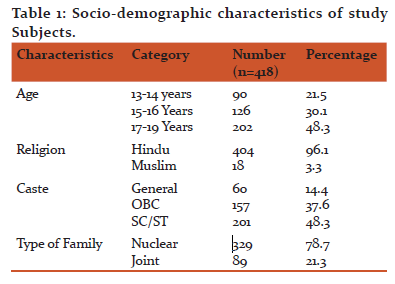
Out of 418 adolescent girls participated in the study, 48.3% belonged to 17-19 years of age group. Majority (96.7) of subjects was Hindu and almost half of them (48.3%) were from SC/ST category. More than three-fourth (78.7%) was from nuclear families and only 21.3% were from joint families.
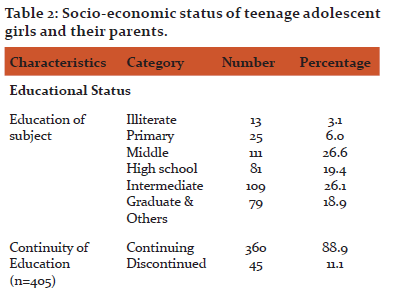
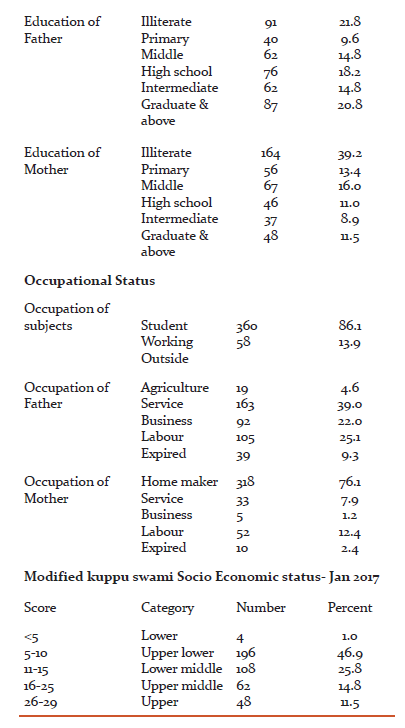
Table 2 represents the socio-economic characteristics of the study participants. Majority (96.9%) of the adolescent were literate and few (11.1%) were discontinued their education. In regard to education of fathers and mothers of study subjects, 21.8% and 39.2% were illiterate respectively. Occupational status of study subject shows, 13.9% adolescent girls were working outside (involve in service, business) and majority of 86.1% of the girls were students. In regard to occupation of fathers, 39.0% were in govt./pvt.Service, one fourth (25.1%) were lobour and 22.0% involved in business where as 4.6% involved in agriculture. Similarly, In regard to occupation of mothers, 76.1 % were house wife and 12.4% were engaged in lobour work and few involved in business/service (9.1%). The maximum percentage (44%) of fathers was labourers, 22% had small businesses, and 10% were in the service sector. It was found that about 47% of the participants belong to upper lower class of socio-economic status followed by lower middle (25.8%), upper middle (14/8%) and upper class (11.5%).
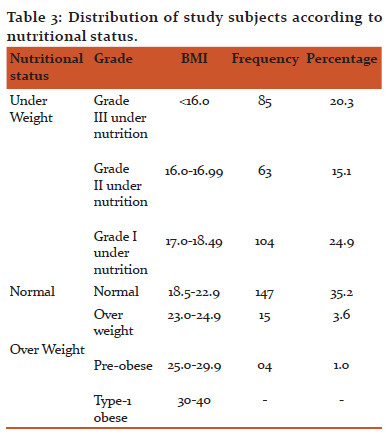
Regarding BMI, more than half (60.3%) were found to be under nourished, among them 20.3% were in grade III, 15.1% in grade II & 24.9% in grade I under nutrition. Around one third (35.2 %) were normal or well nourished, and overweight and pre- obese constitute only 3.6% and 1.0% respectively.
Table 4 describes association between nutrition status and socio demographic variables of teen age girls in urban slum area. The nutritional status of study subjects were significantly associated with age (p<0.0001) and socio economic status (p<0.0001), but other variables like religion, caste, type of family were not associated with the nutritional status of the participants (p>0.05). It was observed that, as the age increases the percentage of undernourishment decreases. In 13-14 years, the percentage of undernourishment was 74.4% whereas in 15-16 years and 17-19 years it was 63.5% and 52.0%, respectively. Similarly the parentage of undernourished is also decreasing as socio economic status increased. In lower and upper lower socio economic class, the percentage of undernourished was 75.5% whereas, in middle lower and middle upper class was 48.2% but in upper class proportion of undernourished was only 39.6%.
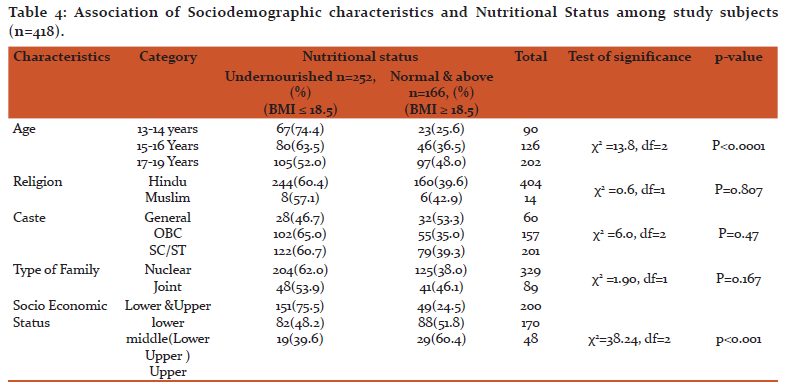
Discussion:
Adolescence is an important stage of growth and development that requires increased nutrition and adolescent anthropometry varies significantly worldwide. [5] Growth and development is closely linked to the diet they receive during childhood and adolescence. [7] Under nutrition among adolescent girls is a serious public health problem internationally, especially in developing countries.[8] Out of 418 adolescent girls participated in the study, 48.3% belonged to 17-19 years of age group. Majority (96.7) of subjects was Hindu and almost half of them (48.3%) belonged to SC/ST category. These findings is very similar to study done by Singh et al in rural area of Varanasi about 91.7 % were Hindu and only 13.4% belonged to SC category which is inconsistent with the finding of this study. [9] In this study more than three-fourth (78.7%) was from nuclear families and only 21.3% were from joint families. Another study also reported similar observations that majority (78.4%) of the respondents were from nuclear family. [10]
Regarding BMI, more than half (60.3%) were found to be under nourished, among them 20.3% were in grade III, 15.1% in grade II & 24.9% in grade I under nutrition. These findings are consistent with other study from Urban India 73.3% girls were under-nourished (BMI<18.5) and prevalence of chronic energy deficiency based on BMI (grade I, II and III) were 23.0%, 28.3%, and 22.2 % respectively.[4] Another study reported 50% adolescent girls were found to be underweight[11]. Other studies from India suggested 53.8% of the adolescent girls were thin (BMI≤18.5) and prevalence of chronic energy deficiency based on BMI (grade I, II and III) were 26.0%, 14.4%, and 13.4 % respectively. [12] In the present study around one third (35.2 %) were normal or well nourished, and overweight and pre- obese constitute only 3.6% and 1.0% respectively, which is very similar to the findings of another study where out of the 230 girls, none of the girls was found to be overweight or obese.[4] The similar finding was also reported by Pratibha et al suggested none of the girls was found to be obese and only 3.6 % girls were overweight.[12] One more study conducted in hilly regions of Bangladesh by Mosarrof et al reported 35 % were normal and 8.33% are overweight and 6.67% are obese. The Body mass index indicator is based on body weight and height, while age is not included in its measurement. In contrast to the findings of this study, Shahid et al found that 20% of the girls are underweight (BMI<18.5), 77% were within normal limits (BMI >18.5), and 3% were obese (BMI > 30). [13] This study also assessed the association between nutritional status and socio demographic variables of teen age girls in urban slum area.
The nutritional status of study subjects were significantly associated with age (p<0.0001) and socio economic status (p<0.0001), but other variables like religion, caste, type of family were not associated with the nutritional status of the participants (p>0.05). However in contrast with the findings of this study, Singh et al found that nutritional status of adolescent girls was significantly associated with their caste and religion (p<0.05)[9] Under-nutrition was significantly high among girls who belonged to Schedule Caste category. Under different caste categories 39.1%, 26.6% and 22% study subjects were underweight in SC, OBC and Other caste groups, respectively. Hindu girls were more vulnerable to under nutrition (27.7%) in comparison to Muslim girls (14.8%). This variation in the trend indirectly represents religion and caste wise variability in food accessibility and dietary intake. [9] In this study, it was observed that the parentage of undernourished is decreasing as socio economic status increased. Another study also suggested significant association with stunting, underweight and socio economic indicators. [14]. Similar to this study one more study conducted in urban slums of Nashik city India Socio economic status were significantly associated with the nutritional status of adolescent girls.[15]
Conclusion: This study found that majority of the adolescent girls is undernourished. These findings of malnourished among adolescent girls in urban slums are quite alarming and steps need to be taken to improve their nutritional status. Therefore, nutrition education and health awareness programs for the adolescents should be implemented in urban slum areas.
References:
1. Ghai O.P., Gupta P. & Paul Vk: Essential Paediatrics; 6th ed. CBS Publishers and Distributors, 2004:66-7.
2. Dasgupta, A., Butt, A., Saha, T.K., Basu, G., Chattopadhyay, A and Mukherjee A. Assessment of malnutrition among adolescents: Can BMI be replaced by MUAC. Indian Journal of Medicine, 2010, 35, (2), 276-279.
3.Choudhary S, Mishra CP, Shukla KP. Nutritional status of adolescent girls in rural area of Varanasi. Indian J Prev Soc Med.2003; 34(1):53-61).
4.Shivramkrishna HR, Deepa AV, Sarithareddy M. Nutritional status of adolescent girls in rural area of Kolar district – A cross sectional study. Al Ameen J Med Sci. 2011; 4(3):243-246.
5.Soumyajit M. Chatterjee K, Kazi AM, Devidas G, Shampad AP; Assessment of Nutritional status of Rural Eraly Adolescent School Girls in Dantan-II Block Paschin Medinipur District, West Bangal; National Journal of community medicine, Vol.2, issue 1, pp 14-18 National J of com. Med. 2011; 2(1):14-18.
6. Deshmukh PR, Gupta SS, Bhasambe MS, Donge MC, Kaur S, Garg BS et al. Nutritional status of adolescents in rural Wardha; IJ Pediatr. 2006; 73(2):139-141. 7. Patil SN, Wasnik V, Wadke R. Health problems amongst adolescent girls in rural areas of Ratnagiri district of Maharashtra. Indian J of clinical and diagnostic research. 2009; (3):1784-1790.
7. Kaur TJ, Kochar GK, Agarwal T. Impact of nutrition education on nutrient adequacy of adolescent girls. Stud Home Comm Sci, 2007; 1:51-55.
8.Rahmathullah L, Underwood BA, Thulasiraj RD, Milton RC, Ramaswamy K, Rahmathullah R, Babu G. Reduced mortality among children in Southern India receiving a small weekly dose of vitamin A. N Engl J Med, 1990; 323: 929-935.
9.Singh S, Kansal S, kumar A(2012) Assessment of Nutritional Status of Adolescent Girls in Rural area of District Varanasi; Indian Journal of Research, Issue 6,30-34
10. Ramya R and Anooja Thomas(2015), Nutritional Status And Dietary Pattern Of Adolescent Girls Of Kottayam Taluk. International Journal of Advanced Research. Volume 3, Issue 4: 949-955.
11.Mosarrof Hossain, Md. Tanvir Sarwar, M. Hafizur Rahman, Shakh M. A. Rouf, Salim Raza, Asad Ud- Daula, Sabir Hossain(2013): A study on nutritional status of the adolescent girls at Khagrachhari district in Chittagong hill tracts, Bangladesh, American Journal of Life Sciences,Vol-1.Issue-6:278-282
12.Patanwar Pratibha, Sharma KKN(2013): Nutritional status of Kurmi adolescent girls of Raipur city Chhattisgarh, India; International Journal of Scientific and Research Publications, Volume 3, Issue 11:1-6.
13.Shahid A., Siddiqui F.R., Bhatti M.A., Ahmed M., Khan M.W. :(2009) Assessment of Nutritional Status of Adolescent College Girls at Rawalpindi. Annals; Vol. 15, Issue 1, Jan-Mar: 11-16
14. Tamanna S, Rana MM, Ferdoushi A, Ishtiyaq Ahmad SA, Rahman M, Rahman A,(2013) Assessment of Nutritional Status among Adolescent Garo in Sherpur District, Bangladesh; Bangladesh Journal of Medical Science Vol. 12 No.3: 269-275
15. Sushama A. Khopkar, Suvi M. Virtanen, and Sangita Kulathinal(2014,); Anthropometric Characteristics of Underprivileged Adolescents: A Study from Urban Slums of India. Journal of Anthropology :1-9
|






 This work is licensed under a Creative Commons Attribution-NonCommercial 4.0 International License
This work is licensed under a Creative Commons Attribution-NonCommercial 4.0 International License